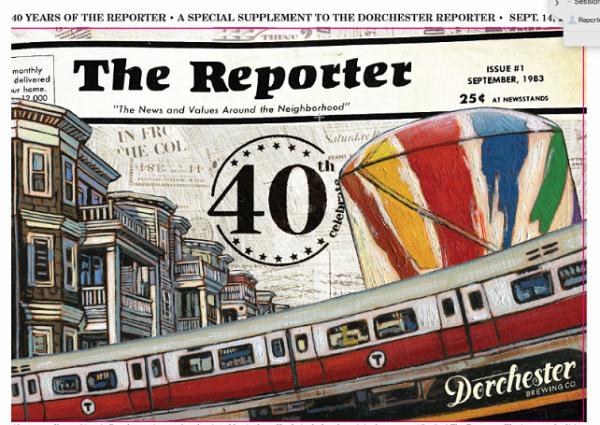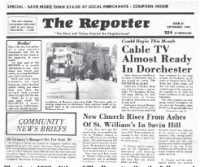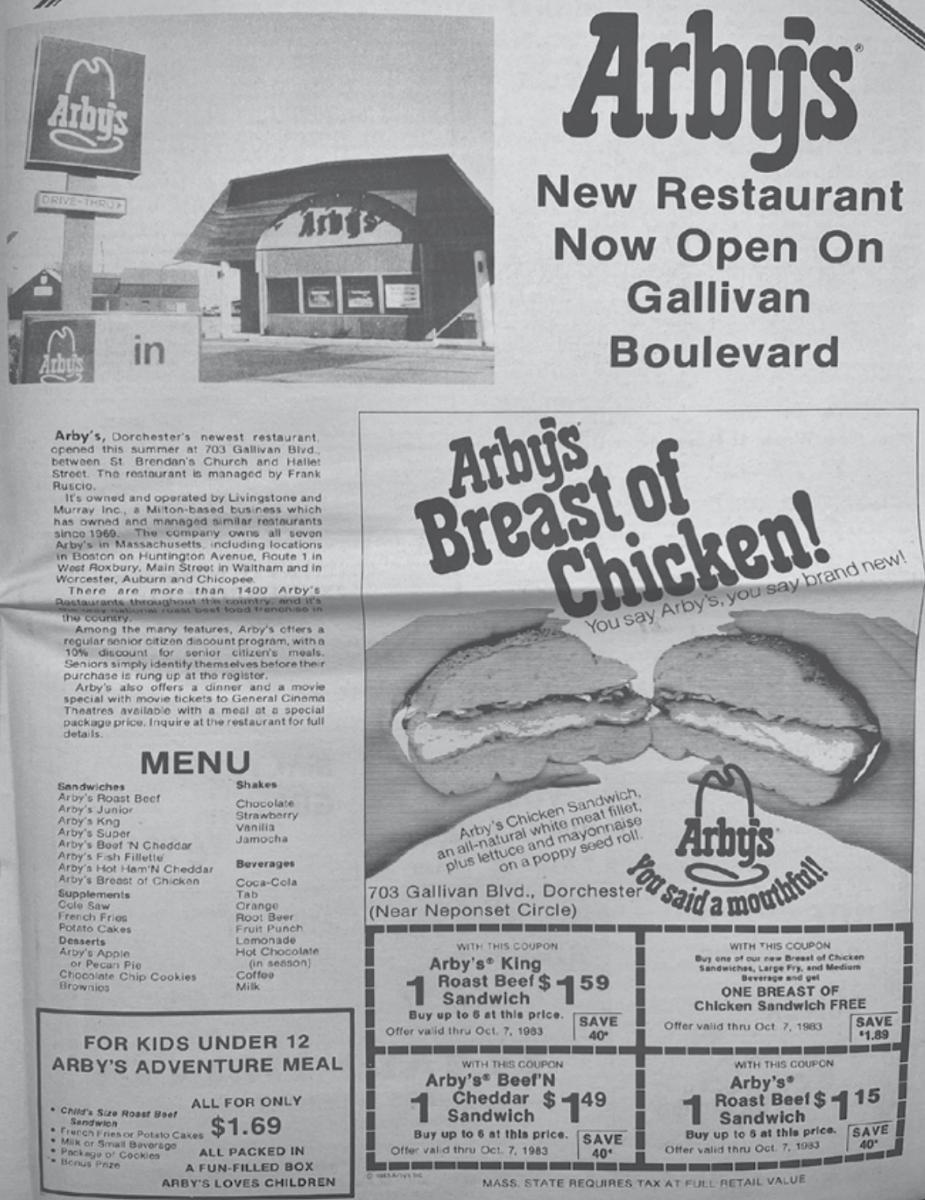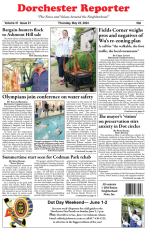September 14, 2023


September 1983.
Ronald Reagan was in his first term as president and the denizens of the Eire Pub already had a portrait of the Gipper – who popped in for a beer in ’82 – framed on their Adams Street wall. The USSR shot down a civilian Korean 747 over Siberia and the US House of Representatives voted unanimously to condemn the Russian atrocity.
The Eurythmics “Sweet Dreams” bumped The Police’s “Every Breath You Take” from the top spot on the Billboard charts. The Baby Boomer college reunion flick “The Big Chill” was number one at the box office. “It’s Like That,” the debut single from rap pioneers Run DMC, dropped that summer. Kids across Boston could at least hum along to Ralph Tresvant’s high notes in the New Edition classic, “Candy Girl.” The first Apple Macintosh home computer, which would revolutionize “desktop publishing,” was set to hit the market in a few months.
In Dorchester, there were still ominous signs of a persistent recession. The Hillside Market in Lower Mills – now a CVS – closed over the summer due to “financial problems.” Purity Supreme, one of Dorchester’s only supermarkets, soon followed suit, laying off 65 people. The twin cinemas that screened films in Puritan Mall on Morrissey Boulevard turn off the lights that fall.
But there were also signs of progress and potential. A new city council and mayor would be seated in fall elections and Dorchester was buzzing with canvassers hitting doors and strapping signs for their chosen candidates. The first 30 or so tenants were hauling furniture and belongings into the old Baker Chocolate factory, which had been rehabbed into apartments that started at $375 for a studio, a cool $430 for a one-bedroom.
Customers at the Swiss House restaurant inside Boston Bowl could get a full bacon-and-egg breakfast, with a side of toast or English muffin, for $2.99. (That included juice and coffee.) The meal would cost you a buck less if you happened to be in possession of a copy of the first edition of The Reporter, a “new monthly newspaper” that hit the front porches and newsstands in select portions of the neighborhood that month. The entrepreneurs behind the start-up tabloid — my parents, Ed Forry and Mary Casey Forry – estimated their readership would be roughly 40,000, a number extrapolated from an industry “standard” that four sets of eyes were likely to get a glance at each of the 10,000 or so copies that actually rolled off the press.
That first edition ran 20 pages and led with a story that proclaimed “Cable TV Almost Ready In Dorchester— Could Begin This Month” next to a photo of a construction crew laying cable down the middle of Richmond Street near the corner of Dot Ave. There’s no byline or photo credit, but the author and photographer could only have been my dad, whose fixation with getting cable television installed at his home and the surrounding neighborhood approached obsessive levels at times during this era. The man wanted his Red Sox games. His son, 10, and daughter, 5, wanted their MTV.
His 39-year-old wife wanted her lawn freed from the “curse” of summer crab grass, a scourge now familiar to the present occupants of 110 Richmond St. We know this because Mary Casey Forry’s debut column on Page 8 of Vol. 1 is a 500-word screed about how her lawn was an abomination and she was under attack by yellow jackets.
“I’m hiding from the neighbors now, ducking in and out of the car, because I know their first question is going to be, ‘Mary! What happened to the garden this year?’” Her byline appeared in The Reporter regularly over the next decade, most often with the monicker she later adopted, perhaps with some irony, “The Urban Gardener.”
The debut edition’s lead feature on Page 4 focused on Tom McCarthy, a Cedar Grove resident who specialized in scaling and painting flagpoles. Once again, there’s no byline, but this time the author quickly admits to his collusion.
“We saw him painting a flagpole in Lower Mills one day last month,” Ed Forry wrote, as if he’d stumbled across the scene. One sentence later: “The pole is on the front lawn of this writer’s home.”
The quirks, malapropisms, and self-owns were toned down in subsequent editions, perhaps because Ed and Mary enlisted more help from neighborhood scribes like Nancy Harrington, who debuted in Vol. 2 alongside Barbara McDonough and her “View from Pope’s Hill” column, which would be featured in The Reporter for the next 37 years.
The 24-page edition that hit the streets in October 1983 included a special “pull-out” section on the preliminary election, which had been pushed back a month due to legislative wranglings earlier in the year. By December, the paper had added yet another plate and ran a robust 28-pages, a sign of growth that was accentuated by a pop of red on the cover of Vol. 4.
The articles are a hoot, but it’s the now-vintage advertisements in the first four volumes that captivate from this side of the century line. Patrons of Thayer Pharmacy in “Lambert’s Rainbow Fruit Plaza” could clip coupons to get $6 off prescriptions or $2 off a 1 lb. box of Whitman’s Sampler chocolates. Adams Sports— which was a favorite stop for 10-year-old youth sports devotees back in 1983— offered Reporter readers 10 percent of “all items in the store.” Jessie’s Hairstyling on Neponset Avenue must have set fire to the blue-haired set in Keystone Apartments with their “Perm Special” that offered $20 off a wash and set. The deal expired on Sept. 24, 1983. There’s no mention of how many discounted perms that Jessie and the girls endured in that two-week stretch but let the record show that there were no such discounts offered in the establishment’s subsequent ads in the fall and winter.
Haircuts, ice skates, and boxes of chocolate are great and all, but the undefeated champion of early-‘80s Reporter coupon clips could only come from the finest fast-food establishment to ever scoop fries and crisp a chicken patty in the nearly 400-year history of Dorchester. Arby’s — which mainly peddled roast beef sandwiches— opened in the summer of ’83 between St. Brendan Church and Hallet Street. It was the seventh Arby’s opened by a Milton-based company and the third one in Boston, if you are among those who count West Roxbury as being part of the city of Boston.
The Dorchester Arby’s was supposedly intended to serve all ages, but it was probably a front for Walt Disney, because it was a pre-teen paradise, especially for Dot kids who thought that visiting Tenean Beach was a day on Cape Cod.

Arby’s coupons in The Reporter were ridiculous. The “Under 12 Adventure Meal” was their answer to the McDonald’s Happy Meal. It offered a sandwich, fries or potato cakes, a small drink, a pack of cookies and a “bonus prize” — all bundled into a “fun-filled” box for $1.69 because “Arby’s Loves Children.” It actually said that in the ad.
Arby’s, it turned out, also loved pre-teens, even teenagers. The breast of chicken sandwiches at the Gallivan Arby’s —which were offered as “buy one-get one” free deals throughout this paper’s first several years of existence— are still my generation’s baseline for chicken sandwich cuisine. Arby’s— combined with ready access to surplus editions of The Reporter— easily contributed about 15 pounds to my middle school and junior high body mass. I still have no idea why that fine eatery closed, but I’m certain it had nothing to do with thousands of Reporter readers raiding its chicken coop nightly.
The Reporter circulated monthly for the first several years of its existence. That was partly because it took so many hours to hand-assemble even a modest-sized publication in the days before Steve Jobs and his garage band figured out how to mass produce Macintosh computers. Until the Forrys could afford those machines, Ed and Mary and their early adopters would schlep over the bridge to a business in Quincy called Galley Graphics to lay out the paper over the course of several days, sometimes weeks. The man who ran the operation inside a converted church building on Willard Street was named Tom Brady and unrelated to the Patriots legend. The Reporter’s Brady developed film on the premises and the fumes from the requisite agents permeated the air. There are still trace elements inside the nasal passages of all who ascended Brady’s spiral staircase and survived the trip down, woozy from the chemicals and the late hour.
Getting The Reporter to your door in those days involved a multi-pronged delivery system that relied mightily on day laborers assembled by Jim “Elastic Band” Carrigan, who would round up a motley crew of otherwise unemployable people to swarm the side streets and chuck periodicals and advertising “circulars” onto porches and, sometimes, through front windows. At some point within the first year or two, several of my St. Gregory’s classmates and I were prevailed upon to pick up a few dollars by joining the offensive for an afternoon. It was a short-lived endeavor, as one too many of the St. Greg’s crew found it easier to simply dump their haul — sans Arby coupons, of course— into a sewer grate on Washington Street rather than finish the assigned route.
All the while, the business of financing the estimable product that you now clutch within your fingers was powered by a sales force of one ¬– Edward Forry, who would daily don his scally cap and steer his ’81 Pontiac sedan across the villages on the hunt for fresh advertisers to try their hand at the coupon game. Rare footage captured by videographers from WCVB-TV’s Chronicle in 1984 shows my father gamely cruising Dot Ave on route to a sales call, intent on convincing his next call that spending a few of their hard-earned dollars on this upstart publication was a worthwhile investment. He delivered his pitches with confidence:
“I go into a sales call believing that I have something that will be good for you, let’s see if we match what it can do with what you need to be done. I believe in the paper. I believe it can work.”
Ed and his team have held fast to that faith-filled credo for four decades and counting. This edition is a testament that those long-ago sentiments, leavened by a love for neighborhood and family, and the craft, has been a labor well worth the effort. We’ve been blessed.
Throughout this fortieth anniversary year, the current team at the Reporter will periodically look back at the people and events that peppered our coverage in those early months. Next month, we’ll bring you more on the man whose photo graced the second edition of The Reporter: Joseph Corcoran, whose vision and persistence led to the transformation of the Columbia Point peninsula.
Bill Forry is the executive editor and publisher of the Reporter.


